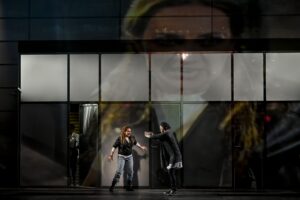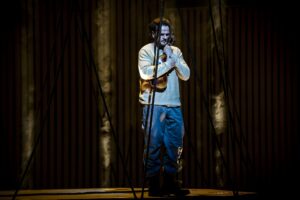Dalibor the knight did really exist and was an ambiguous figure, to say the least. He came from an old family from Kozojedy, Central Bohemia. In 1483 his father, Aleš of Kozojedy, acquired the Mnetěš estate in the Litoměřice district, near the village of Ploskovice, where one of the first peasant revolts in the region took place thirteen years later. The peasants refused to fulfil their serf duties, seized the estate of the local feudal lord Adam of Drahonice, and then placed themselves under young Dalibor’s protection. Dalibor cleverly took advantage of the situation, seizing not only his neighbour’s lands and stronghold, but also his labour force. Knocked about and humiliated, burgrave Adam decided to assert his rights. He sued Dalibor in a Prague court and won, especially as the young scallywag was a reoffender: a few years before his own father had accused him of misappropriating part of his younger brother’s property. Dalibor was found guilty, but he did not give the cows, pigs and grain back to Ješek, which ended in another lost lawsuit, this time brought by his brother.
Dalibor’s case, brought by Adam of Drahonice, led to the establishment of a legal precedent which provided not only for the return of seized property, but also for the death penalty for the villain, who had taken the rebellious peasants under his protection. Dalibor was arrested on the orders of King Vladislav (that is, the Polish prince Vladislav II Jagiellon), and then imprisoned, apparently as the first ever prisoner, in a tower on the premises of the Prague Castle, today referred to fondly as Daliborka. The sentence was passed on 13 March 1498. Dalibor lost all his property, his noble title and his head: in the literal sense, as he was beheaded with an executioner’s axe. The later legend of the defender of the oppressed was written down only by Jan František Beckovský, a historian and member of the Order of the Knights of the Cross with the Red Star, author of Poselkyně starých přjběhůw cžeských, one of the most important tools of Czech patriotic education in the eighteenth century.
Jana Šrejma Kačírková (Jitka). Photo: Marek Olbrzymek
The story, along with the claim that Dalibor learned to play the violin in the castle tower, was picked up by Josef Wenzig, who submitted to Smetana a proposal for a German libretto even before the premiere of The Bartered Bride. The composer sketched the first act in October 1865 and completed the whole thing two years later – with an unabashed sense that he had created his life’s work. He was all the more upset by the cool reception of Dalibor, which after its premiere on 16 May 1868 at the Prague Provisional Theatre was labelled an “anti-national” opera , full of treacherous references to Wagner’s hated oeuvre. Despite hasty alterations, Dalibor disappeared from the repertoire for nearly twenty years and did not return to the public’s good graces until Smetana’s death. In the late nineteenth century it conquered Vienna and Germany. It appeared probably only once in Warsaw, in 1902. Popular in Czechia, after the WW2, in the 1960s, it slowly began to make its presence felt in the West, mainly through guest appearances of Czech companies (though not only thanks to them: in 1977 Harold C. Schonberg wrote warmly about it after a concert performance at Carnegie Hall, with New York ensembles and Teresa Kubiak as Milada, alongside Nicolai Gedda in the title role). The opera has been attracting increasing interest recently in German-speaking countries, being advertised as a Czech Lohengrin or Czech Fidelio. In 2024 it inaugurated the Moravian celebrations of the Year of Czech Music at the Janáček Theatre in Brno, in a new staging by David Pountney.
Dalibor is an undoubted masterpiece, although Smetana’s unparalleled melodic invention and sonic imagination is not always matched by the coherence of the dramatic concept. The narrative gets bogged down here and there, and sometimes strays into psychological improbability. In the first act we have an astonishing coup de foudre from Milada, who seems to be acting as a witness for the prosecution in the court scene, only to fall madly in love with Dalibor at the sight of the perpetrator of the ill-fated raid. There is an intriguing homoerotic subtext in Dalibor’s affection for the fiddler Zdeněk, who was killed by the burgrave – it runs through the opera until its finale, in which the knight, having rapturously reciprocated Milada’s love, dies with the names of both of them on his lips.
It is, therefore, not surprising that the producers of the Brno staging decided to make some cuts in the score, return to the original ending, and make some “improvements” to the Czech version of the libretto, written by Erwin Špindler. Less convincing is the decision to divide the three-act opera into two parts (before the first set change in the second act), if only because Jitka’s meeting with her beloved does not match, either musically or dramaturgically, the material of the first act. What appeals the least to the imagination is the director’s overall vision – Pountney has come up with the idea that Dalibor is a thoroughly political work and, worse still, decided to get this concept across to us extremely chaotically. The combination of allusions to the events of the Prague Spring with references to the figure of Bobby Sands and other IRA members who went on the tragic hunger strike in 1981, fighting for the status of political prisoners, does not add up to a universal picture of a struggle for the freedom of an oppressed nation, let alone provoke the audience to reflect on whether Dalibor was a brave defender of the weak or simply an ordinary villain. Especially since such reflections have nothing to do with the story told by Smetana.
Csilla Boross (Milada) and Peter Berger (Dalibor). Photo: Marek Olbrzymek
And that story is intricate enough and at times incoherent enough for a responsible director to resist the temptation to encase is in a plethora of additional meanings. Yet in Dalibor Pountney, an artist with an huge body of work and some truly outstanding productions to his credit, has taken dozens of his own and others’ ideas from the past half-century, and stitched together a veritable theatrical Frankenstein-like monstrosity – with the help of Robert Innes Hopkins (set design) and Marie-Jeanne Lecca (costumes). The first act brings to mind the beginning of Lohengrin in any provincial German theatre: glass, steel, ranks of police in riot gear, video projections, a courtroom – seemingly abstract, but with the emblem of the double-tailed Bohemian lion – King Vladislav in a tyrant’s uniform straight from an operetta, and Jitka, a girl as innocent as the water lily in Smetana’s vision, transformed into a seasoned militia fighter. The updated battle scenes are reminiscent of analogous episodes from stagings by Calixto Bieito, Olivier Py and even Mariusz Treliński, but in a cost-cutting version (apart from the sizeable arsenal of machine guns). The Fidelio-inspired prison scenes with Dalibor and Milada in male disguise, on the other hand, become a cheesy allegory with a few unexpectedly realistic touches (the burglar locksmith’s tool kit in Milada’s backpack). Zdeněk’s ghost looks like a caricature of the one-winged Gottfried the swan from the Welsh Lohengrin directed by Antony McDonald – also barefoot, but wearing a too tight suit and with a bloodied wing. As if it were not enough for Pountney that the opera ends badly, he has Vítek, Jitka’s beloved, die at the beginning of Act Two – without any convincing justification later on in the narrative.
Fortunately, everything was more than made up for by the musical side of the production. I decided to go to see the penultimate performance in this run because of its almost entirely Czech and Slovak cast, artists who understand Smetana, know what they sing about and know how to do it. Contrary to what might have been thought, not far behind in this respect was the Hungarian Csilla Boross, a singer well acquainted with the repertoire, having been a resident artist at the National Theatre in Brno years ago. Her dark, rounded dramatic soprano is perfect for the big and, at times, fiendishly difficult role of Milada, and her minor problems with Czech pronunciation were more than made up for by her musicality and expressive characterisation. Peter Berger triumphed in the title role. His is a jugendlichen Heldentenor in the peculiarly “Slavic” version, resonant, healthy, with a beautiful golden honeyed tone. Berger is also a fine actor and has an excellent stage presence. In many respects he can already be considered a worthy successor to Beno Blachut, the legendary performer of the role. I’m very glad I got to see a performance featuring Svatopluk Sem, who sang the dilemmas of King Vladislav with a bass-baritone that was bright, supple and free at the top, with a typically “Smetanian” phrasing that enabled him to breathe much more humanity into his character than the director had envisaged. An outstanding Jitka came from Jana Šrejma Kačírková, aptly cast with Ondřej Koplík as Vítek (a lovely duet of these two at the beginning of the second act).
Peter Berger. Photo: Marek Olbrzymek
However, all these marvels would not have been possible had it not been for the superb orchestra, the phenomenal chorus and Tomáš Hanus, a reliable conductor in this repertoire, who conducted Dalibor not only with exuberant energy, but also – perhaps above all – with an uncommon sense of the treasures contained in this score. Hanus does not waste time on pondering whether Dalibor was a villain or an angel: he makes sure he brings out from the brilliant orchestral texture everything that shines differently; accentuates each of the motifs that would inspire Dvořák himself; makes Zdeněk and his singing violin sound not only in the words of the protagonist, but throughout the piece, in each string part – as a metaphor for the nation’s identity born through art, the most powerful weapon in the Czechs’ struggle against oppression.
In this respect Pountney was right. Dalibor is a thoroughly political opera. However, it did not occur to him that this policy was pursued with music, not guns.
Translated by: Anna Kijak



